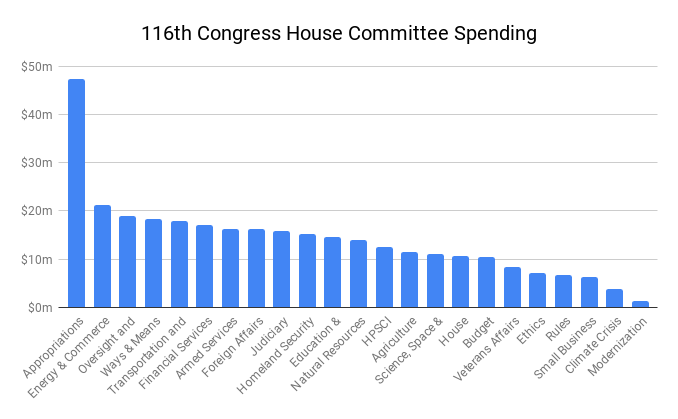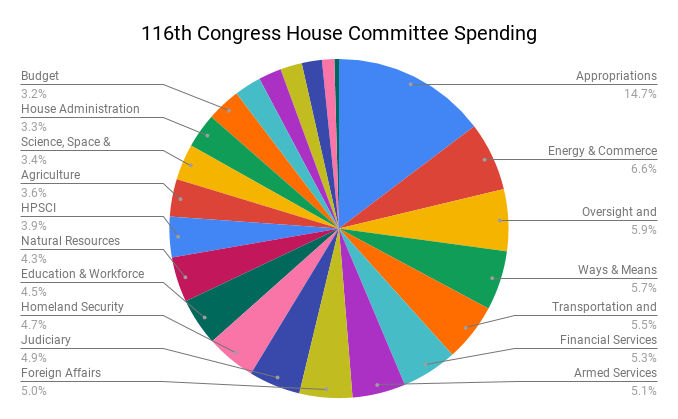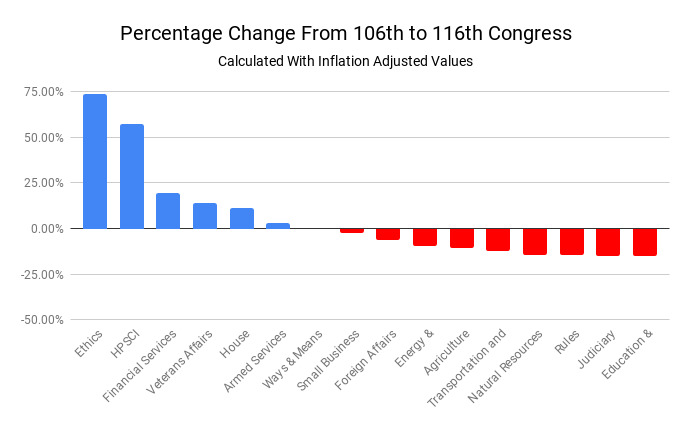(This is an update of a 2019 article on how House Committees are funded. It has been updated for the 116th Congress.)
Committee funding in the House of Representatives is accomplished through a somewhat quirky process. Appropriators in the House Legislative Branch Appropriations Committee set a top dollar amount for the committees — they appropriate the funds — but it is the Committee on House Administration that provides (i.e. allots) the funds to each committee on a biennial basis.
At the beginning of each new Congress, each committee chair and ranking member jointly testifies before the House Administration Committee and requests funds for their committee. For the 116th Congress, the hearing took place on March 12, 2019. Here is the committee notice; the written statements requesting funds; and video.
On March 21, the House Administration Committee introduced a funding resolution in the House, and on March 25, the committee held a markup on House Resolution 245 that allotted funds to the committees. You can watch the very brief proceedings here. House Administration reported out the committee report on March 26th, and the House passed the resolution on March 27.
HOW FUNDING FOR COMMITTEES HAS CHANGED OVER THE LAST 25 YEARS
What does this look like in practice? Drawing upon the excellent data in this CRS report, plus a little additional research on spending on the appropriations committee, we looked at:
- Total committee spending from 1995 to present
- The change in spending per committee from 1999 to present
- Spending per committee in the last Congress
What did we find? Overall, committees have significantly fewer funds available than their recent historical counterparts, which undermines their ability to do their jobs.
(Want to check our math? You can see our data here: un-adjusted committee spending data from 1995-2020 and inflation-adjusted committee spending data from 1995-2020.)
TOTAL COMMITTEE SPENDING
Total spending on committees is down by more than $115 million from its peak, using inflation adjusted dollars. The House of Representatives put $322,333,439 towards its committees in the 116th Congress, down from $437,680,105 in the 111th Congress, which incidentally was when Democrats last controlled the House. This is a 25% cut in funding. As a point of comparison, spending on the Capitol Police for FY 2020 amounted to $464,341,000.
What’s interesting is that committee spending is down from when Republicans last controlled both the House and the White House, in the 109th Congress. At that time, committees received $408,629,237 in inflation adjusted dollars, which is almost $90m more than the most recent Congress.

SPENDING PER COMMITTEE
In the 116th Congress, the appropriations committee received far and away the lion’s share of committee funding, more than double the next closest committee. The following two charts show how the last Congress prioritized its committee spending. As mentioned above, it is worth noting that the overall pie has shrunk considerably.


CHANGES IN SPENDING PER COMMITTEE
As the overall spending pie for committees has shrunk, who has come out ahead and who has lagged behind? Ethics, Intel, Financial Services, Veterans Affairs, House Administration, and Ways and Means are all up, but this can be deceiving. Ethics ($6.8m), Veterans Affairs ($8.3m), House Administration ($10.6), and Intel ($12.4m) have comparatively tiny budgets, as compared with quite well funded Financial Services ($17.1m) and Ways and Means ($18.3) committees.
Similarly, Rules, Appropriations, Budget, and Oversight appear down, but this too can be misleading. Rules ($6.6m) and Budget ($10.4m) are comparatively small, whereas Oversight ($18.9m) is the third largest committee, and Appropriations ($47.4m) is the largest.

WHAT DOES ALL THIS MEAN?
House Democrats could increase funding for committees by 20-25 percent and still be within historical norms for committee spending. Indeed, what the data shows is that the House’s committees have been hollowed out in recent years.
The biggest likely constraints on returning to normal allotment levels are that the legislative branch budget is comparatively smaller than historical norms, and it will be hard to find the money. Spending on other items consume a comparatively larger share of legislative branch funds.
This suggests that when Democrats start the Budget process, in which they will decide how much money to make available to the 12 appropriations subcommittees, they should look to increase funds to the legislative branch.
A FEW FINAL NOTES
First, and not to make things too complicated, but the allotment process (the divvying up of funds among the committees) happens only once, at the start of each Congress, and the allotment resolution covers a two year period. By contrast, the legislative branch appropriations process, which is what okays the spending of money, happens every year. You can imagine the appropriation as Congress spending money to buy a pie, and the allotment process as cutting up pieces for each committee. The appropriation and allotment process run on different calendars, which can make things confusing.
Second, generally speaking, funds for a committee are further subdivided, with 2/3s available to be spent by the majority and 1/3 by the minority. This isn’t always true, such as for the Ethics committee, and there can be other considerations, but that’s generally how it works. One notable exception is the Modernization Committee, which has a bipartisan staff. In addition, the funds are generally allotted in two segments, for each year of the Congress.
Third, in some Congresses there is a separate reserve fund, just in case a committee overspends.
Fourth, while most committees are allotted funding, Appropriators appropriate funding specifically for the Appropriations Committee in a separate line item.
Finally, the last time there was a select environmental committee, back in the 111th Congress (2009-2010), the committee was allotted $4,968,243 (in inflation-adjusted dollars); by comparison the Select Committee on the Climate Crisis created during the 116th Congress was allotted $3,781,500.
This report is an update to our January 15, 2019 report “How House Committees Get Their Money,” which analyzed House committee allotments up to and including the 115th Congress.